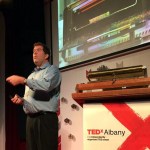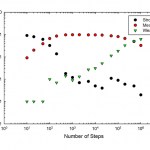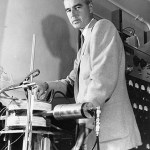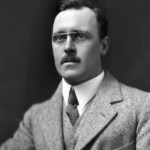Atoms and Molecules
This one's late because I acquired a second class for the Winter term on very short notice. I was scheduled to teach our sophomore-level "Modern Physics" class, plus the lab, but a colleague who was scheduled to teach relativity for non-majors had a medical issue, and I'm the only other one on staff who's ever taught it, so now I'm doing two courses instead of one. Whee!
Anyway, here are my December posts from Forbes:
-- Science Is Not THAT Special: Another in a long series of posts grumbling about the way we set science off from other pursuits and act as if the problems facing it are unique…
It's been a month since the last links dump of posts from Forbes, though, really, I took a couple of weeks off there, so it's been less than that in terms of active blogging time. But I've put up a bunch of stuff in July, so here are some links:
-- The Physics Of Ancient Roman Architecture: First of a couple posts inspired by our trip to Rome, this one looking at the basic mechanics of the key structural element of Roman building, the arch.
-- What Ancient Roman Buildings Teach Us About Science And Engineering: Second post about Roman construction, in which looking into the question of how…
Another few weeks of physics blogging at Forbes, collected here for your convenience.
-- Commercialization Of Space: Three Cheers For The Mundane: Some belated but brief comments on the SpaceApps conference I went to down in NYC.
-- How Studying Atoms On Earth Helps Us Learn About Other Planets: As a snobby grad student in cold-atom physics, I thought of old-school spectroscopy as boring and pointless, but a recent DAMOP session showed how those classic atomic physics studies still have a lot to offer for studies of astrophysics.
-- Are The Constants Of Nature Changing, And How Can We Tell?:…
I was at the APS March Meeting last week, because I needed tp give a talk reporting on the Schrödinger Sessions. But as long as I was going to be there anyway, I figured I should check out the huge range of talks on areas of physics that aren't my normal thing-- in fact, I deliberately avoided going to DAMOP-sponsored sessions.
This also affected my blogging, so the last few weeks' worth of posts at Forbes have mostly been on March Meeting-related areas:
-- How Cold Atoms Might Help Physicists Understand Superconductors: A post about the connection between ultra-cold atomic physics and…
A long-ish stretch of time, but I was basically offline for a bunch of that because I needed to finish a chapter I was asked to contribute to an academic book. So there are only four physics posts from Forbes to promote this time:
-- 'The Expanse' Is A Rare Sci-Fi Show That Gets Simulated Gravity Right: Another post on the SyFy adaptation of "James S. A. Corey"'s books, talking about a nifty bit of visual effects that nods at the Coriolis force you'd see on a rotating space station.
-- What Is The Quantum Pigeonhole Principle And Why Is It Weird?: A paper published in the Proceedings of the…
So, yesterday was my big TEDxAlbany talk. I was the first speaker scheduled, probably because I gave them the title "The Exotic Physics of an Ordinary Morning," so it seemed appropriate to have me talking while people were still eating breakfast...
The abstract I wrote when I did the proposal mentions both quantum physics and relativity, but when I actually wrote the talk, that made for a really awkward transition, so it's all quantum, all the time. I cover quite a bit of ground-- the no-animation-effects version of the slides is 42 slides and Word has it as just over 2500 words written out…
There's a new Science Express paper on interfering clocks today, which is written up in Physics World, with comments from yours truly. The quote is from a much longer message I sent-- with no expectation that it would end up as anything other than a pull quote, I might add, but I thought the background would be helpful. Since I ended up doing a back-of-the-envelope estimate for that, though, I thought I would reproduce some of the reasoning here.
The basic proposal idea here is to do an atom interferometer inside a Ramsey interferometer for making an atomic clock. That is, before sending the…
I've been really busy with year-end wrap-up stuff, but have also posted a bunch of stuff at Forbes. which I've fallen down on my obligation to promote here... So, somewhat belatedly, here's a collection of physics-y stuff that I've written recently:
-- Using Atoms To Measure Tiny Forces: A post reporting on some very cool atom interferometry experiments, one working to measure the very tiny (but known to exist) force of gravity, the other searching for a possible "fifth force" sort of thing.
-- Making And Shaking New Materials With Ultracold Atoms: A post reporting on a couple more DAMOP…
I'm at DAMOP this week, though it took longer to get here than it should've-- severe storms yesterday canceled the flight I was supposed to take from Baltimore to Columbus, so I had to rebook to the 6am departure this morning, whee. I think this is the first time I've ever had a flight canceled while I was at the airport, though which is kind of amazing.
Anyway, I missed most of the morning session, and I'm short on sleep, but I saw some cool talks already, and expect to write about some of them tomorrow. For the moment, though, here's a post I wrote for Forbes yesterday talking about why…
I'm massively short on sleep today, and wasn't going to blog until I saw somebody on Facebook mention that June 5th 1995 is the date of record for the first Bose-Einstein condensate at JILA in Boulder. I couldn't let that pass, so I wrote it up for Forbes:
Twenty years ago, in the summer of 1995, I was a young grad student having just finished my second year at Maryland, and one morning I packed into the conference room at the National Institute of Standards and Technology (NIST) in Gaithersburg (where I worked in the group of Bill Phillips) with most of the rest of the Atomic Physics…
Last week, I did a post for Forbes on the surprisingly complicated physics of a light bulb. Incandescent light bulbs produce a spectrum that's basically blackbody radiation, but if you think about it, that's kind of amazing given that the atoms making up the filament have quantized states, and can absorb and emit only discrete frequencies of light. The transition from the line spectra characteristic of particular atoms to the broad and smooth spectrum of black-body radiation is kind of amazing.
The way you get from the one to the other is through repeated off-resonant scattering. The…
I was proctoring an exam yesterday in two different sections of the same class, so I had a lot of quite time. Which means I wrote not one but two new posts for Forbes...
The first continues a loose series of posts about the exotic physics behind everyday objects (something I'm toying with as a possible theme for a new book...), looking at the surprisingly complicated physics of an incandescent light bulb. A light bulb filament emits (to a reasonable approximation) black-body radiation, which is historically important as the starting point for quantum physics. But when you think about it, it's…
I'm still in the late stages of an awful cold, but shook it off a bit to write a new conversation with Emmy, the Queen of Niskayuna over at Forbes:
“HEY! YOU POODLES! STAY OFFA MY LAWN!”
“Emmy! Stop barking!” I sit up. She’s at the gap between the fences, where she can see into the front yard.
“But, those poodles..”
“We’ve had this conversation. It’s a public street, other dogs are allowed to walk on it. No barking.” She comes over, sheepishly. “Why can’t you just lie down and enjoy the nice day, hmm?”
“Well, I would. But, you know… Quantum.”
“What?”
“I would love to just lie in the sun, but…
One of the things I struggle with a bit when it comes to writing about cool modern physics is how much to play up the weirdness. On the one hand, people just can't get enough of "spooky action at a distance," but on the other hand, talking too much about that sort of thing makes quantum physics seem like a completely bizarre theory with no applications.
Which is unfortunate, because quantum physics is essential for all manner of everyday technology. For example, as I try to explain in a new post at Forbes, quantum physics is essential to the cheap alarm clock that wakes me up in the morning.…
I'm rooting around in my bag for a pen, and pull out a laser pointer by mistake. Since I'd really prefer not to be grading, I flip it on and shine it on the floor next to the spot where Emmy is half-dozing. She immediately leaps up (she's pretty spry for a dog of 12...), and pounces on it. Or tries to, as I flick the spot across the room.
"Get the dot! Get the dot! Getthedotgetthedotgetthedot!" she mutters as I lead her on a lively chase around the room. After a few minutes, I click the laser off, and put it down. Emmy comes over, panting, and I scratch behind her ears.
"That was fun, eh,…
Rhett Allain has a list of 5 Things Every Human Should Know About Light, to tie in with the International Year of Light, and it's a good list with lots of .gifs. Of course, there are some gaps, so let me offer some additional things that everyone ought to know about light:
-- Light Is a Particle
Rhett and I have a long-running argument about the use of photons in introductory physics; he's against them for reasons that make no sense to me. To my mind, it is unquestionably true that light has particle-like properties (and here's a follow-up with some math), and that's a thing that everybody…
SteelyKid missed the bus this morning-- she was dressed and ready, but I was talking to Kate, and if there isn't a person at the end of the driveway when the bus comes around the corner, they won't stop. So I drove her over to school myself (which is faster, anyway). The GE research lab complex is behind her school, so there's a nice view from the parking lot to the eastern horizon, where the sun was just poking over a big band of clouds.
"Hey, look at that cool sunset!" she said as we were walking from the car to the building.
"That's not a sunset, honey, it's a sunrise. It's morning."
"Oh,…
One of the very best books I ran across in the process of doing research for Eureka is The Second Creation: Makers of the Revolution in Twentieth-Century Physics by Robert P. Crease and Charles C. Mann. It's an extremely detailed treatment of the development of quantum theory, and includes anecdotes that I haven't seen elsewhere. It also does a fantastic job of showing the essential interplay of experiment and theory through the difficult process of developing quantum field theory, which is often underplayed in popular treatments (which tend to be written by theorists, and often treat…
"You wanted to see me, Herr Professor?"
"Hans! Yes, come in, come in. Just going over the account books. Frightful amount of money going out of this place."
"Well, radium is expensive..."
"Ha! Oh, and speaking of which-- here's one of the sources. Absent-mindedly dropped the fool thing in my pocket last night when I locked up. Terrible habit, I really must work on that. Had a drawer full of the things in Montreal..."
"Thank you. And you wanted to see me about...?"
"Oh, yes. We have a new student, Hans, and I'd like you to put him to work on the gold foil project."
"Shouldn't he have his own…
Back in August, I gave a talk in Stockholm at the Nordita workshop for science writers, about precision measurement searches for physics beyond the Standard Model. There's now video of this online:
The video quality isn't great, but if you'd like a clearer look at the slides, I've posted them on SlideShare. The talk was divided into two parts, though the video is not:
Part 1:
High Precision, Not High Energy: Using Atomic Physics to Look Beyond the Standard Model (Part I) from Chad Orzel
Part 2:
High Precision, Not High Energy: Using Atomic Physics to Look Beyond the Standard Model (…




